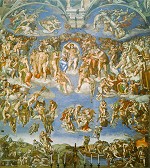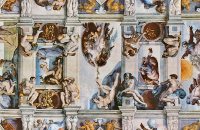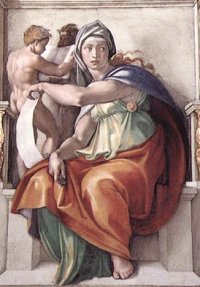|
 
- 积分
- 43492
- 威望
- 9279
- 金钱
- 8
- 阅读权限
- 150
- 来自
- Bonn
- 在线时间
- 3551 小时
|
2#
 发表于 2008-8-6 07:46
发表于 2008-8-6 07:46
| 只看该作者

The Sistine Chapel

礼拜堂内部,面对入口。左面的露台是为唱诗班准备的。

礼拜堂内部,面对讲坛.
As Pope Sixtus IV needed a chapel for domestic services he orderedthe architect Giovanni dei D-o-l-c-i(这里被论坛认为是其他论坛,连写会被过滤) to build him one. That was in 1473;the building was finished in 1481.
The Sistine Chapel is still being used by the Pope, mostly forofficial ceremonies. After the death of a pope, Roman Catholiccardinals from all over the world gather in the chapel to elect asuccessor. Today, the building is part of the museums of the Vatican.
The chapel has a rectangular shape. It measures 41 × 13 meters (134× 43 ft.) and was built using somewhat ordinary bricks. From theoutside there is nothing spectacular about the building. It has abarrel-shaped roof, topping 20 meters. On the inside, the chapel isdivided into 2 by a transenna: a fence made from marble. The part facing the altar is only accessible to priests.
Each of the two long walls has 6 large arched windows. The walls arecovered by 3 virtual rings with decorations. At floor level: tapestrydesigned by Raphael, showing scenes from the gospels and the Acts. In the middle: frescoes with scenes from the lives of Moses and Jesus. The top row, next to and between the windows, shows images of popes.
The choice to display both Moses and Jesus was no coincidence. Itwas meant to visualize the continuity between the old and the newcovenant, Moses' laws and Jesus' teachings. Originally the storiesstarted on the wall behind the altar. They still meet on the wall abovethe entrance.
The paintings on the walls and on the ceiling are widely consideredto be the peak of Renaissance art. Most praise goes to Michelangelo'sceiling and Last Judgment on the wall behind the altar.
Several popes have had their say in the development of the art inthe chapel. In that process, three phases can be distinguished:
- 1481 through 1483: still during the pontificate of Sixtus IV(1471-1484) all the walls were decorated. Pier Matteo d'Amelia painteda starry sky on the ceiling.
- In 1508 pope Julius II hired the Florentine master Michelangeloto decorate the ceiling and the lunettes above the windows. The workwas finished in 1512. The ceiling shows nine scenes from Genesis. Inthe lunettes ancestors of Jesus are depicted, as mentioned in Matthew 1.
- In1536 Michelangelo was again called upon. This time it was Pope Paul IIIwho hired the master to make a fresco of the Last Judgment on the rearwall of the Sistine Chapel behind the altar. This was finished in 1541.
北墙

This wall is devoted to the life of Jesus. From left to right:
南墙

This wall has frescoes with scenes from the life of Moses. From right to left:
EntranceA part of the wall containing the entrance door collapsed in 1522, destroying several frescoes: the Resurrection of Jesusby Domenici Ghirlandaio and Luca Signorelli's fresco of the discussionson Moses' remains. They were replaced at a later date by works on thesame subjects by Hendrick van den Broeck and Matteo da Lecce.

后墙: 最后的审判

It was Pope Paul III who asked Michelangelo to decorate the wall behind the altar with a fresco showing the Last Judgment:the moment when God judges man. Previously, in the 15th century, PietroPerugino had decorated the wall with an altarpiece and 2 frescoes. Theywere related in subject matter to the side walls showing episodes fromthe lives of Moses and Jesus.
Michelangelo's fresco was inaugurated in 1541 after five years ofpainting. After the master's death most of the fresco's genitals werecovered upon the insistence of prudent priests. The fresco was restoredin 1993; the cover-ups were left as they were.

天花板

The painting of the ceiling took four years. It took its toll onMichelangelo's health: working on his back, an impressive amount ofpaint must have entered his lungs. But it was certainly worth theeffort.
After finishing the work in 1512, Michelangelo switched to makingsculptures, hardly painting anything until 1536, when he started on theLast Judgment.
The central part of the ceiling shows scenes from Genesis. On bothsides are several Biblical prophets and some sibyls: female prophetsfrom ancient times, who, according to the Church, had predicted thecoming of Jesus. Among the prophets are all the major ones: Isaiah,Ezekiel, Jeremiah and Daniel. In the lunettes above the windows anumber of Jesus' ancestors are shown, Boazbeing one of them. It is unclear who the figures in the triangularparts above the lunettes represent. The corners of the ceiling show therescuing of the Israelites, which was seen as a prelude to theSalvation.
Scenes from GenesisProphets and Sibyls(先知和女先知)

Seated above the entrance is Zechariah.(撒迦利亚) Along the northern wall, from left to right: the Libyan Sibyl, Daniel,(但以理) the Sibyl from Cumae, Isaiah,(以赛亚) and the Delphic Sibyl.

Delphic Sibyl

Along the southern wall, from left to right: Joel,(约耳) the Erythrean Sibyl, Ezekiel,(以西结) the Persian Sibyl, Jeremiah.(耶利米) The prophet above the altar is Jonah,(约拿) who got to be in this eye-catching spot because he is often seen as a predecessor of Jesus.
Visiting the Sistine ChapelThe chapel is located in Vatican City, a tiny independent state entirely surrounded by Rome. Entrance is free on the last Sunday of every month. Crowd alert.
[ 本帖最后由 qquchn 于 2008-8-6 08:03 编辑 ] |
|











